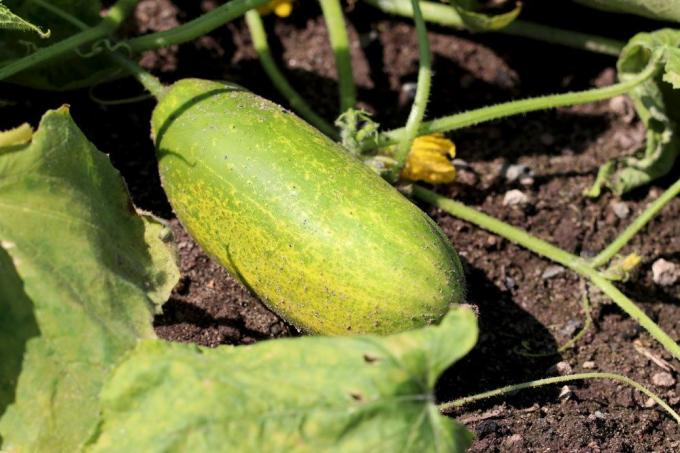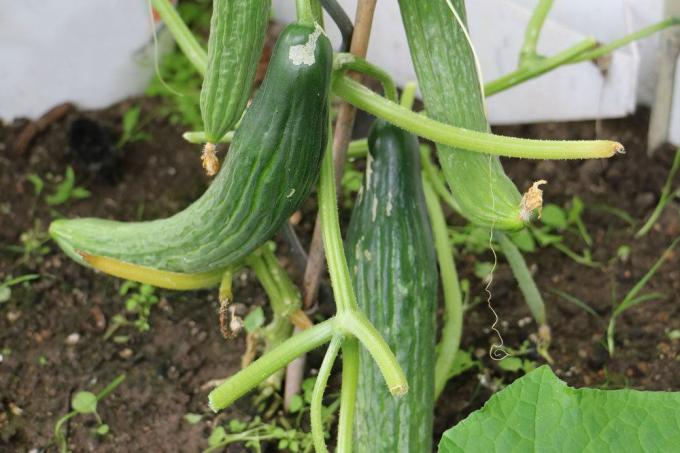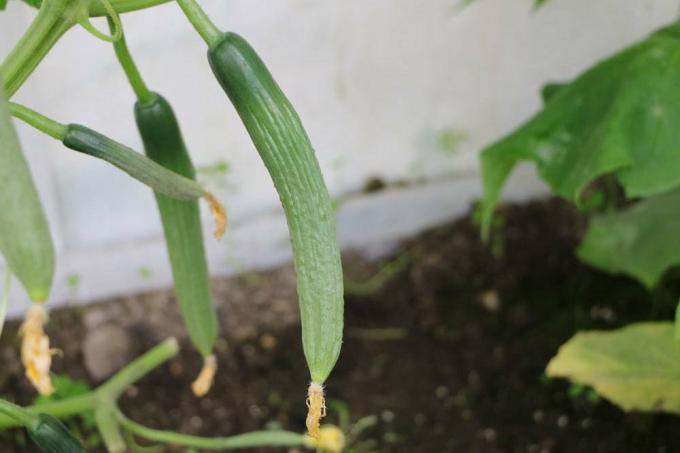
table of contents
- Cucumber
- Glasshouse
- Infections
- Countermeasures
- Pests
- Countermeasures
- Outdoors
- Infections
When the leaves on cucumber plants turn yellow, you should usually act quickly. The reasons for this can have various origins, which must be found out. The plant expert explains clearly how you can identify the cause and how you should act to save the plant and prevent it from spreading.
Cucumber
Cucumbers in the greenhouse / open field turn yellow - what they lack
Both cucumbers in the field and in the greenhouse are equally affected when it comes to yellow leaves, which in the worst case can cause the plant to die. The most common cause for this is based on incorrect care, although cucumber plants are also not resistant to fungi and parasites. The first step is always to identify the problem so that you can choose the right response to get your cucumbers healthy.
Glasshouse
While diseases and parasites on the yellow leaves of the cucumbers are mostly to blame for outdoor cucumbers, In the case of greenhouse cucumbers, this is mainly limited to care errors and / or a wrong one Room climate. The latter, for example, leads to yellow leaves if the following is not given.
- constant and constant air circulation (avoid drafts)
- constant high humidity
- opening the ventilation ducts in the morning and closing them in the evening
- Soil temperatures of at least 10 degrees Celsius
- germ-free soil (avoid waterlogging)
- sufficient plant spacing

Infections
Greenhouse infections
In many cases, greenhouse cucumbers are only threatened by fungal infestation if they are preceded by incorrect care, as already described in the section “Greenhouse cucumbers”. As a result, two types of fungus in particular can develop on the cucumber plants:
Cucumber wilt
If the cucumber wilt was caused by the soil fungi Verticillium or Fusarium, you are currently left with no choice but to dispose of the plant as there is currently no effective control against it gives. The leaves of the cucumber turn yellow from the stem onwards. The coloring takes up the entire leaf relatively quickly and this then falls off. Overall, the plant looks very limp and the wilting process is progressing rapidly.
Verticillium wilt
Verticullium wilt is also a harmful fungus that spreads rapidly and infects countless types of plants. This disease can be recognized by the following appearances.
- Wilting despite sufficient watering
- leaves that turn yellow quickly
- Cracks and death of stems or wooden parts of plants
- overall ill appearance

The infection occurs from the ground, where the roots are weakened and an infestation is usually only recognized after a long time. Like cucumber wilt, Verticullium wilt is not treatable. Immediately remove it from the rows of plants and dispose of it in the household waste.
Leaf spot disease
Leaf spot disease triggers a bacterial infection. You can usually recognize them by the yellowish spots on the upper side of the leaves. In addition, drops of mucus can be seen on the underside of the leaves. At an advanced stage, the yellow spots on the leaf become larger and larger and take up the entire leaf, until it tears, wilts and the yellow color changes to brown.
The causes are usually too high humidity and injuries through which the bacteria can get inside the plant. The pathogen can get into the soil with seeds and linger there for a very long time.
mildew
Powdery mildew is a fungal disease that is divided into two different types: powdery mildew and downy mildew. In both cases, the harmful fungi cause yellow leaves and, in the absence of treatment, cause the infected plants to die off. Both types of powdery mildew can be recognized by a whitish and sticky fluff film. In powdery mildew, this is on the upper side of the leaf, while in downy mildew it is limited to the underside of the leaf. If the fungal infection continues, the leaves are completely covered with this fluffy carpet and the leaves then turn yellow at the latest.

Countermeasures
Infection treatment
With the exception of the cucumber and the Verticillium wilt, the mentioned infectious diseases relatively easy to get to grips with if they are recognized early and treated accordingly early on will. Basically, the more advanced the fungal attack, the lower the chances of survival.
Home remedies
For the treatment of fungal diseases, spraying with skimmed milk generally helps. The advantage of skimmed milk is that it is in no way harmful to health and the cucumbers are still suitable for consumption or there is no waiting time.
Proceed as follows to manufacture and use:
- mix one cup of fresh, low-fat milk with three cups of water
- alternatively, mix whey in a ratio of 1: 1
- Pour the mixture into a spray bottle
- Spray plants dripping wet once a day
- after about a week the fungus should have died
- only use freshly prepared

Fungicides
The market offers a wide range of fungicides that are both biodegradable and available with chemical ingredients. The latter is not recommended as it involves treating food and making it inedible for at least a year. But also with ecological products you have to pay close attention to the ingredients, because even if they are are named as suitable for vegetables, a waiting period may be necessary be. Therefore, combating yeast infections in cucumbers with home remedies is always the better choice and only on Use fungicides when the population is threatened over a large area and rapid control is required will.
Pests
Greenhouse pests
The typical pests of cucumbers that thrive in the greenhouse include a particular species. Should these be seen or even suspected, immediate action is required to remedy the infected To keep the plant from dying off and to spread over a large area to the rest of the plant population avoid.

Spider mites
These pests are difficult to recognize with the naked eye because of their small bodies to a maximum of one millimeter in size. With a magnifying glass, red eyes can be seen as well as their eight legs. Depending on the season and temperatures, they have body colors of green, orange or red-brown. They feel particularly at home in dry climates. In a warm greenhouse they colonize cucumber plants all year round if you let them. The damage usually looks like this.
- small bright spots on the leaves
- Formation of fine webs on leaf axils and leaf margins
- brown spots appear
- then the leaf turns completely yellow
- The number of leaves is continuously decreasing
Countermeasures
Pest Control
If there is a parasite infestation, chemical products should generally be avoided in the vegetable plant. With almost the same effect, but much less harm to health, are BIO plant products that contain, for example, the so-called neem oil as the main ingredient. This settles in the respiratory tract of the spider mites and other pests and ultimately leads to death by suffocation. Neuendorff and BAYER offer these in their range, for example.
Home remedies
Moisture application is even more optimal than organic fungicides, but with a longer effect.
- Shower plants with high water pressure
- Enclose individual plants dripping wet with plastic wrap
- if a whole table is infected, pull the plastic sheet over it completely
- In any case, make sure that it is somewhat airtight
- Maintain the foil seal for about three to four days - DO NOT OPEN!
- then examine the plants carefully for any remaining spider mites
- repeat the process if necessary
Beneficial insects
The use of beneficial insects is effective against spider mites and many other pests. Ladybirds in particular devour countless types of mites every day and, depending on the number of beetles, can rid even large populations of these parasites within a few days.
TIP: By the way, you can easily get beneficial insects in a well-stocked gardening shop. This saves you a lot of time attracting the animals and you can tackle the fight accordingly faster.

Outdoors
Since cucumbers are exposed to different weather conditions in the field than cucumbers in a greenhouse, They show typical field diseases or pests, such as the following in particular three:
Infections
Real and false cucumber powdery mildew
As already described under the heading “Greenhouse Infections”, powdery mildew and downy mildew are also a serious problem for cucumbers in the field. The fungal attack manifests itself in the same way as with the greenhouse attitude and can also with corresponding BIO pesticides or even better, combated with appropriate household remedies with whey or low-fat milk will.
Cucumber mosaic virus
This virus usually comes into the kitchen gardens via seeds and weeds, where it is mostly distributed via gardening and pruning tools as well as aphids. He predominantly prefers cucumbers and pumpkins, but also uses numerous other types of plants. The name is based on the typical mosaic appearance that it causes on the cucumbers or the fruit. The virus cannot be transmitted to humans, but plants infected with this virus are not allowed for sale in Germany.
Other identifying features include:
- Leaf deformations and compressions
- young leaves show yellow spots
- older leaves turn light yellow
- Leaves wither
- Cucumbers take on unusual shapes
- restricted growth behavior
Combat:
If the cucumber mosaic virus is recognized as this, infected specimens must be disposed of immediately. It is advisable to separate the cucumbers that have already grown from neighboring plants and to throw them in the household waste. In addition, virus-free specimens in the immediate vicinity must be supplied with organic green manure and an extra portion of magnesium in order to strengthen their immune system. A new planting in the same place should only be done after a large area change of soil.
Aphids
Aphids are typical for outdoor cucumber plantations and are less common in greenhouses. There they only creep in occasionally and mostly only in the seasons when they are looking for warmth in the cool outside temperatures. Their body usually reaches a maximum of three millimeters in length, with some specimens up to eight millimeters in size. Depending on the species, they have a green, yellowish or brown color and usually collect in colonies on the stems. Classic signs of aphid infestation are as follows.
- stunted leaves
- sticky leaf coating (honeydew)
- yellow leaves falling off

Combat:
The same methods with neem oil or beneficial insects can be used as control measures as described for parasites in the greenhouse. Only when using an effective home remedy for aphids does a spray solution made from milk provide a quick solution to the problem. Proceed as follows to prepare and use.
- Mix 200 milliliters of water and 100 milliliters of milk
- Pour the solution into a spray bottle
- Spray the affected cucumber plants dripping wet from all sides
- Don't forget the leaf roots, stems, shoots and undersides of the leaves
- Apply the solution once a day
- after about four days the aphids should be gone
- always use fresh milk
Conclusion
At the latest when yellow leaves or the first yellow discolouration are noticeable on the leaf of a cucumber, there is usually one behind it Serious illness, a pest infestation or it is a sign of incorrect care or bad care Housing conditions. In any case, the consequence is usually the death of the plant if action is not taken quickly. With the help of this guide, you can safely identify the problem so that you can react correctly and, above all, protect other plants in the vicinity.



